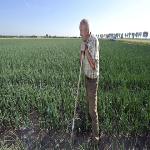2011-6-27

Photo: AP
Farmer Winfried Rothermel in his onion field in western Germany last month
This is the VOA Special English Agriculture Report.
Onions come in different sizes, shapes, colors and flavors, from mild and sweet to hot and strong. A full-grown onion plant has roots, bulbs and leaves. The leaves are long, thin and hollow. They stand straight up and thicken at the bottom to form a bulb.
Onions are biennials; their life cycle is two years long. But they are usually picked during their first year after flowers form and the bulbs stop growing.
Onions grow best in loose, fertile soil. They can grow in many different climates. In cooler climates, onions may need fourteen to fifteen hours of daylight to start forming bulbs. In warmer climates, onions can begin developing bulbs with fewer hours of daily sun.
Barbara Fick is an extension agent at Oregon State University in the northwestern United States. She says a faster way to grow onions is to plant what are called sets.
BARBARA FICK: "Onion sets are actually small plants, versus starting with a seed. So when you have a set, onion set, it actually is, you know, the small bulb."
Organic material like compost or leaf mulch can help onions grow in heavy soil.
The bulbs can be pulled from the ground once their tops have dried and fallen over. Onions can be stored for months. But Barbara Fick says stored onions need to be cured first.
BARBARA FICK: "Curing is a way of making sure those leaves on the outside are nice and dry."
Here are some directions from editors at the National Gardening Association.
First, dry the onions in the sun for a day or so. Then bring them out of direct sun for two to three weeks. Spread them out in any warm, airy place that is covered. Or cover the onions with a light cotton sheet held in place with stones along the edge.
The sheet will keep the sun from burning the bulbs. Don't worry about rain. And do not use a plastic or canvas sheet. Heavy coverings will trap moisture and keep the onions from drying fully.
Turn the bulbs a couple of times to help them dry evenly.
After curing the onions, you can hang them indoors in mesh bags to dry even more. There should be no wet spots on the onions when they are put in storage. Editors at the National Gardening Association say the longer onions are cured, the better they will keep.
Some people cut off the top leaves before curing onions. If you do that, do not cut the leaves any closer than two and a half centimeters from the bulb.
And that's the VOA Special English Agriculture Report, written by Jerilyn Watson. For more stories about gardening, including more advice about growing onions, go to 51voa.com. I'm Bob Doughty.